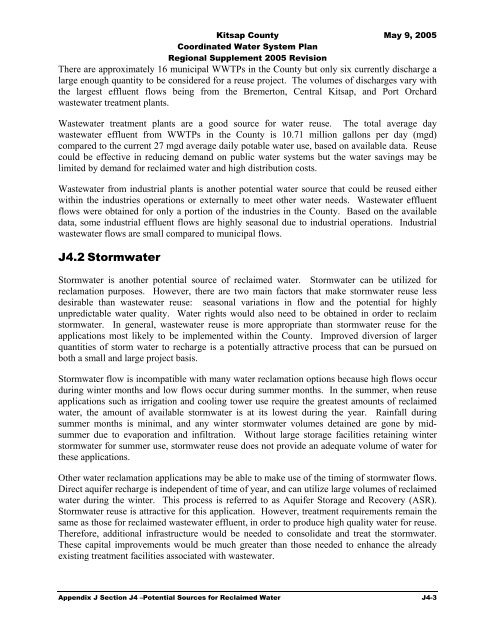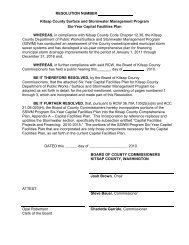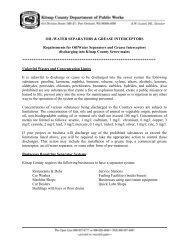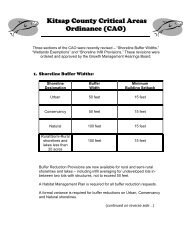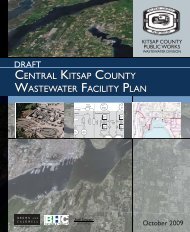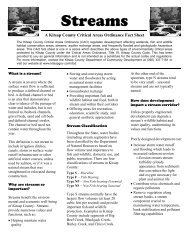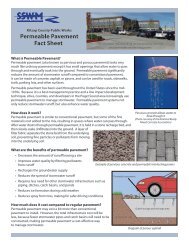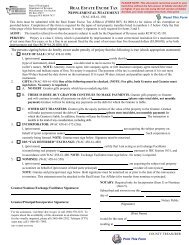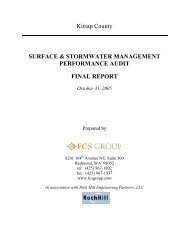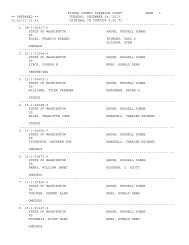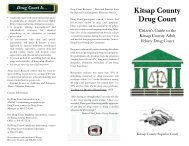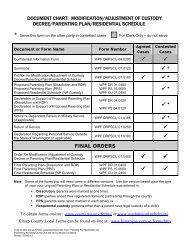Coordinated Water System Plan - Kitsap County Government
Coordinated Water System Plan - Kitsap County Government
Coordinated Water System Plan - Kitsap County Government
You also want an ePaper? Increase the reach of your titles
YUMPU automatically turns print PDFs into web optimized ePapers that Google loves.
<strong>Kitsap</strong> <strong>County</strong> May 9, 2005<br />
<strong>Coordinated</strong> <strong>Water</strong> <strong>System</strong> <strong>Plan</strong><br />
Regional Supplement 2005 Revision<br />
There are approximately 16 municipal WWTPs in the <strong>County</strong> but only six currently discharge a<br />
large enough quantity to be considered for a reuse project. The volumes of discharges vary with<br />
the largest effluent flows being from the Bremerton, Central <strong>Kitsap</strong>, and Port Orchard<br />
wastewater treatment plants.<br />
Wastewater treatment plants are a good source for water reuse. The total average day<br />
wastewater effluent from WWTPs in the <strong>County</strong> is 10.71 million gallons per day (mgd)<br />
compared to the current 27 mgd average daily potable water use, based on available data. Reuse<br />
could be effective in reducing demand on public water systems but the water savings may be<br />
limited by demand for reclaimed water and high distribution costs.<br />
Wastewater from industrial plants is another potential water source that could be reused either<br />
within the industries operations or externally to meet other water needs. Wastewater effluent<br />
flows were obtained for only a portion of the industries in the <strong>County</strong>. Based on the available<br />
data, some industrial effluent flows are highly seasonal due to industrial operations. Industrial<br />
wastewater flows are small compared to municipal flows.<br />
J4.2 Stormwater<br />
Stormwater is another potential source of reclaimed water. Stormwater can be utilized for<br />
reclamation purposes. However, there are two main factors that make stormwater reuse less<br />
desirable than wastewater reuse: seasonal variations in flow and the potential for highly<br />
unpredictable water quality. <strong>Water</strong> rights would also need to be obtained in order to reclaim<br />
stormwater. In general, wastewater reuse is more appropriate than stormwater reuse for the<br />
applications most likely to be implemented within the <strong>County</strong>. Improved diversion of larger<br />
quantities of storm water to recharge is a potentially attractive process that can be pursued on<br />
both a small and large project basis.<br />
Stormwater flow is incompatible with many water reclamation options because high flows occur<br />
during winter months and low flows occur during summer months. In the summer, when reuse<br />
applications such as irrigation and cooling tower use require the greatest amounts of reclaimed<br />
water, the amount of available stormwater is at its lowest during the year. Rainfall during<br />
summer months is minimal, and any winter stormwater volumes detained are gone by midsummer<br />
due to evaporation and infiltration. Without large storage facilities retaining winter<br />
stormwater for summer use, stormwater reuse does not provide an adequate volume of water for<br />
these applications.<br />
Other water reclamation applications may be able to make use of the timing of stormwater flows.<br />
Direct aquifer recharge is independent of time of year, and can utilize large volumes of reclaimed<br />
water during the winter. This process is referred to as Aquifer Storage and Recovery (ASR).<br />
Stormwater reuse is attractive for this application. However, treatment requirements remain the<br />
same as those for reclaimed wastewater effluent, in order to produce high quality water for reuse.<br />
Therefore, additional infrastructure would be needed to consolidate and treat the stormwater.<br />
These capital improvements would be much greater than those needed to enhance the already<br />
existing treatment facilities associated with wastewater.<br />
Appendix J Section J4 –Potential Sources for Reclaimed <strong>Water</strong> J4-3


